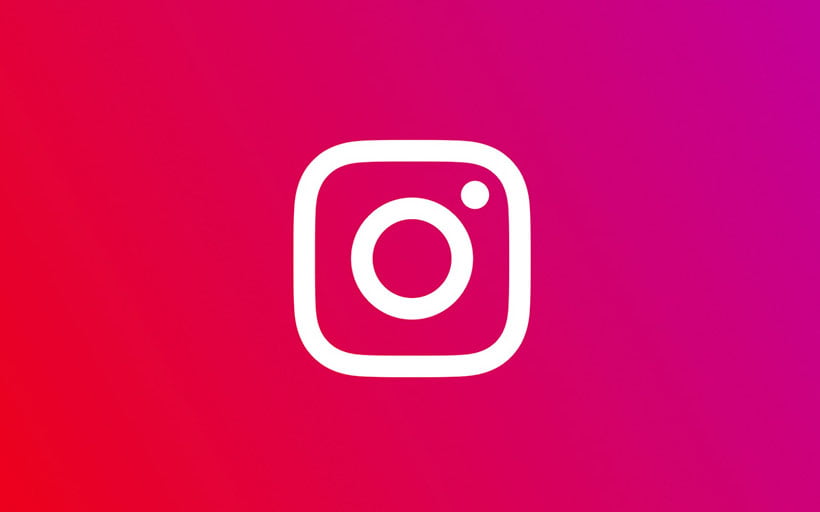How to create a nurture sequence for your print on demand business

Tags
Interested in joining the world's leading print on demand platform?
Did you know that just 3% of web visitors are instantly ready to buy?
About 50% of your visitors will never buy, and 47% aren't ready to buy now, but they might be in the future.
It's the 47% of shoppers on which you need to work your magic. These are the people that are going to become leads, and then hopefully customers.
In this article we want to focus on what you do with those leads. When someone first signs up to your mailing list, your relationship is fresh and new, and the lead could still be a long way from making a purchasing decision. That's where a nurture sequence comes in.
A nurture sequence is a series of automated emails that are triggered for a new lead. Each email in the sequence is designed to nurture your leads, gently nudging them towards a sale — hence the name.
It's important that these emails are automated because:
- It allows you to respond to the immediate needs of your leads.
- It would be very time-consuming to send all of these emails out manually!
Plus, automated emails perform better. Automated emails receive an average of 70.5% higher open rates and 152% higher click-through rates than ‘business as usual' emails.
Nurture sequences for print on demand
Whatever your creative print on demand niche is, it's important to remember that having unique designs, great branding, and awesome products is just half of the battle. The other half is generating traffic and then focusing on getting your website visitors to convert.
And, as we've discussed, nurture sequences can help you do that. The good news is that if you host your print on demand store on Shopify or BigCommerce, then setting up a nurturing sequence is actually pretty easy.
Both sides have several email marketing apps that can be installed with just a couple of clicks:
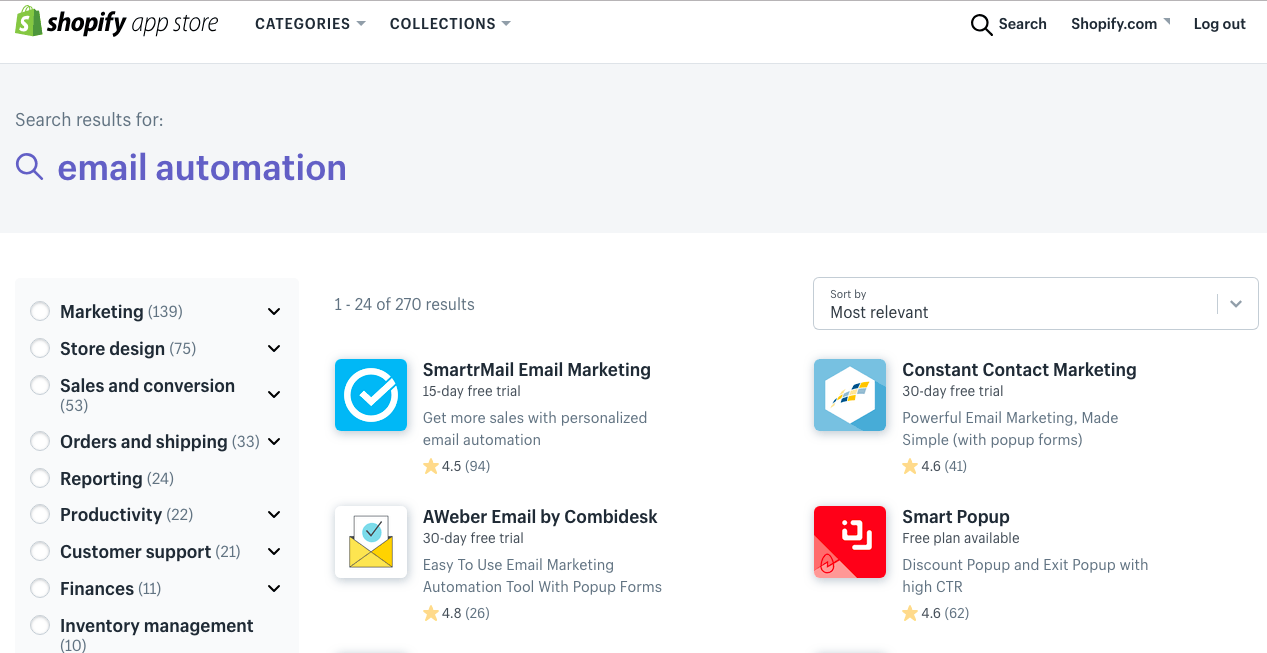
Some are free, and some require a monthly fee but offer a free trial. We'd recommend taking advantage of a free app or a free trial so that you can get to grips with email automation first and start generating a return from it before you are tied down to monthly payments.
Mailchimp is an app that can be found on both platforms (in fact, it can integrate with practically any site) and it also has a free plan that allows you to send 12,000 monthly emails to 2,000 subscribers. That's more than enough to get started.
Mailchimp is also very beginner-friendly. When linking it with BigCommerce, you can choose from a variety of templates:
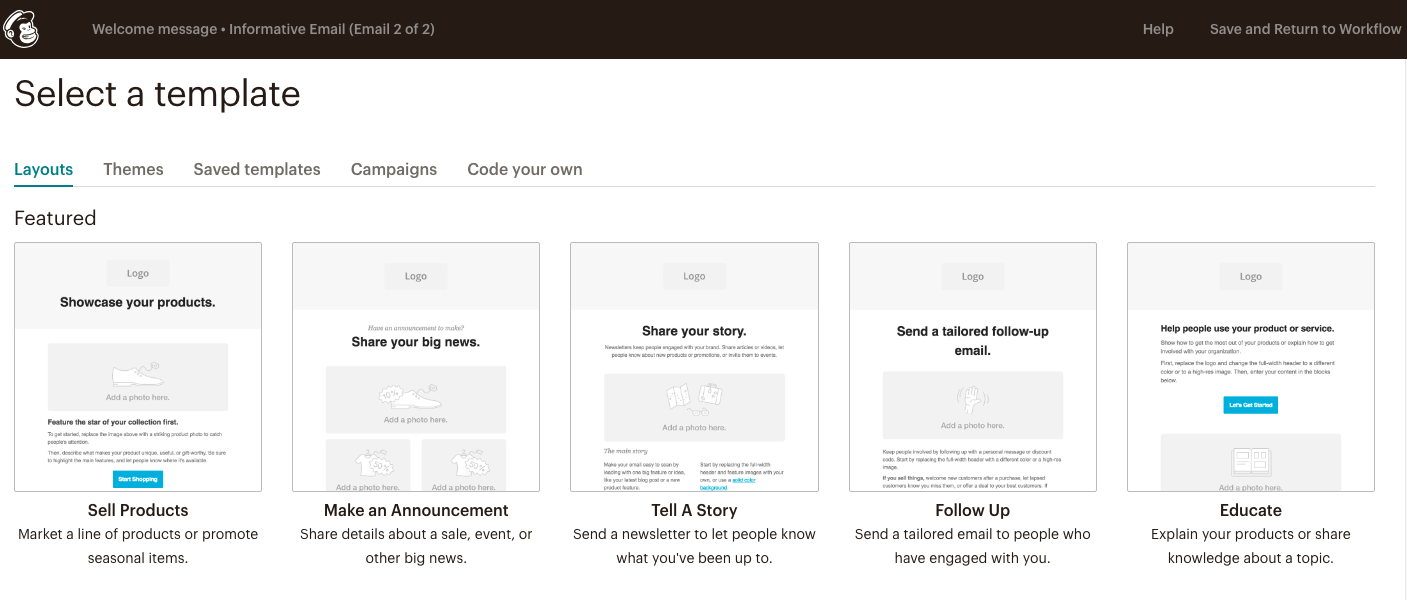
And update these according to your needs:
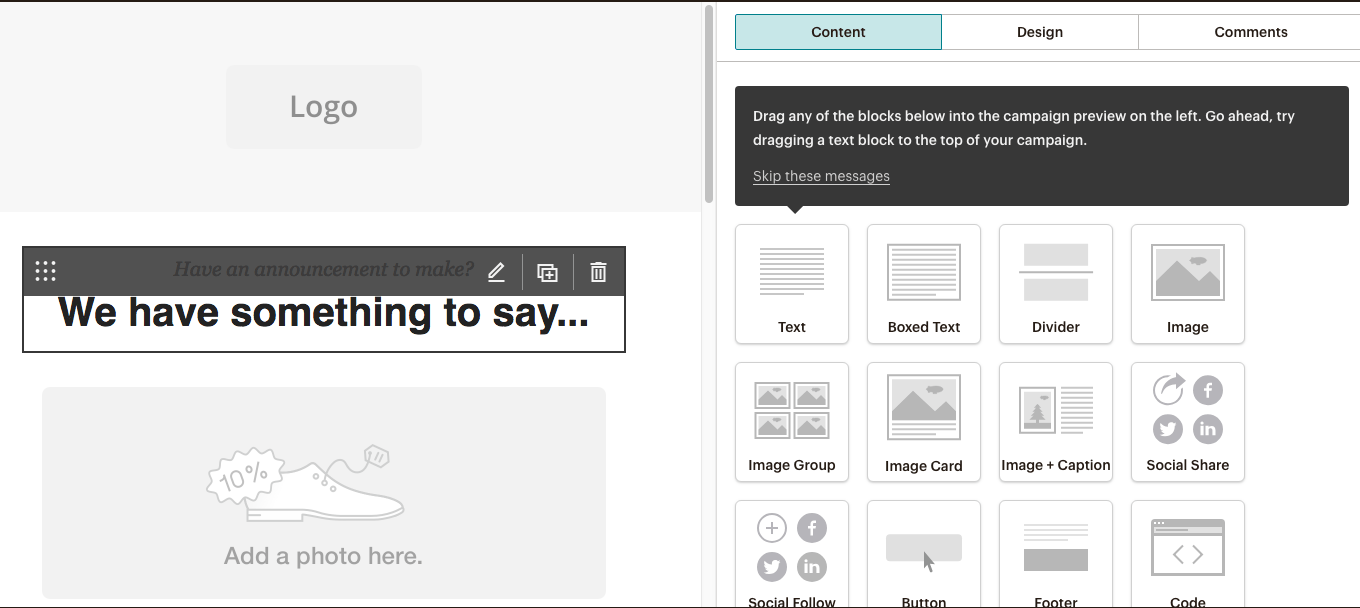
Pretty soon, you'll have a fully-fledged nurture sequence:
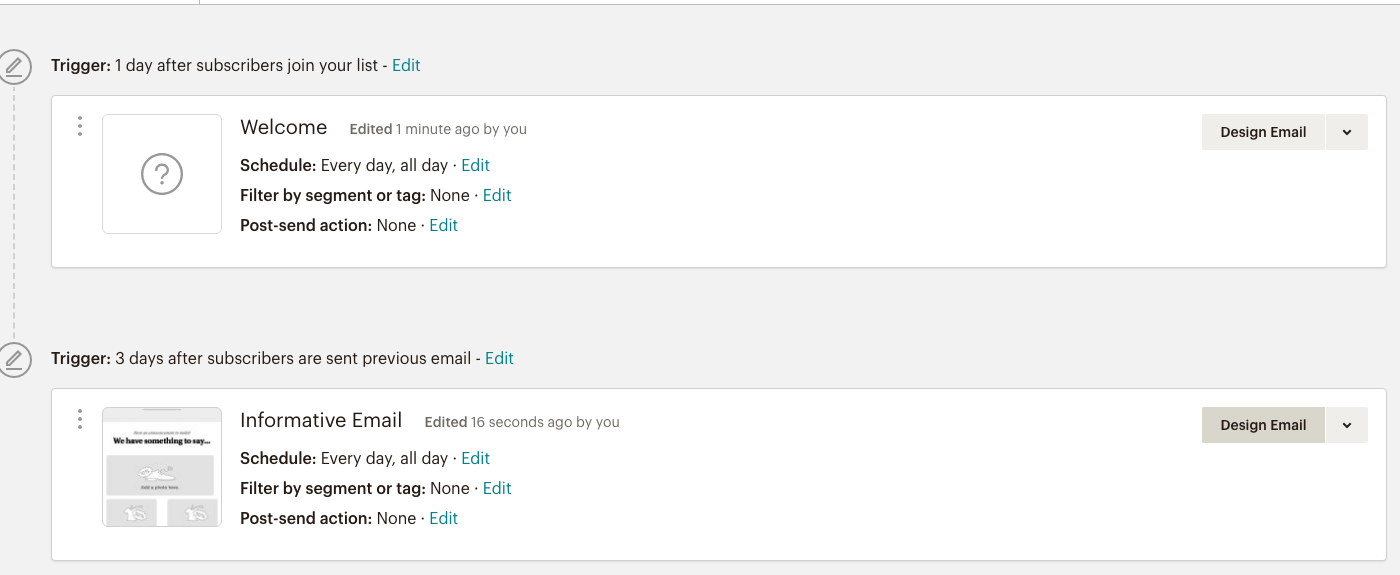
If you are managing a traditional website or have a storefront, you can still invest in software like MailChimp that works with any leads you generate. You can simply import these into the platform in Excel or CSV format.
When it comes to content, a typical email nurturing sequence will follow this course:
- Welcome Email An opportunity to introduce your business and make a great first impression — this is typically sent immediately after you have captured your lead's email address
- Informative or Social Proof Email Let them know more about your business and why they should purchase from you — this should be informative, don't go in with the hard sell just yet!
- Incentive Email Now it's time to sell! Send out a generous offer that can't be refused.
- Educational Email When a customer makes a purchase, add even more value for them by helping them get the best use out of your product
- Re-engagement Email Check in with the customer to see if they are still interested in your products and try to bring them back for more
This is a very simple framework that you can use as a starting point. However, it is important to note that not everyone is going to convert after email no.3, so you may need to create an additional layer of emails to further nurture those people.
It may help to think of your nurture sequence as a road with forks (based upon how people respond or don't respond), rather than a straight highway.
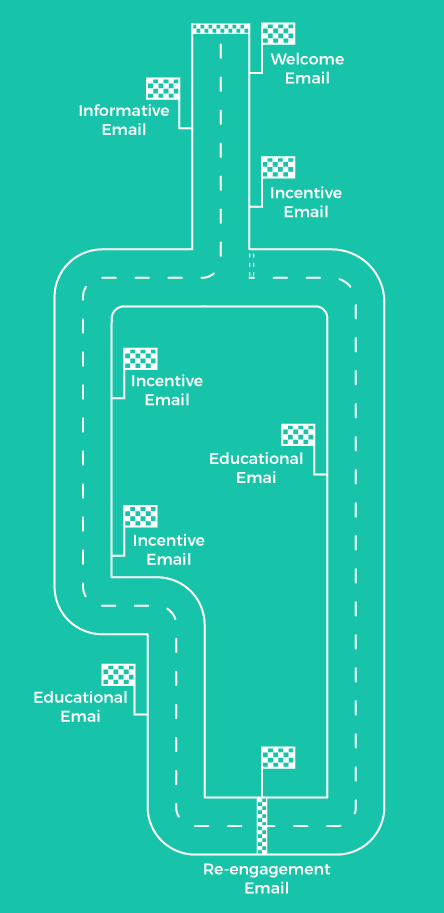
Let's take a look at each email in more detail and study how they help to nurture leads towards becoming customers…
Day One: The friendly hello (welcome email)
When someone signs up to your mailing list, you should ensure they have a welcome email in their inbox within seconds. According to one email marketing study, subscribers that receive a welcome email show 33% more long-term brand engagement.
Your welcome email should be exactly that — a welcome, and nothing more. At this point, an agenda (like increasing sales) is only going to scare your brand new leads away. Instead, focus on building a relationship with them and show off a bit of your brand's personality. Here is an example by a company called Harry's:
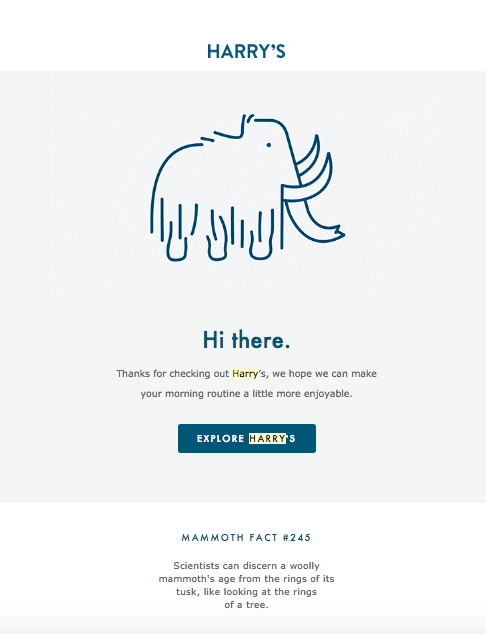
This email is simple and to the point. It introduces the brand with one line and gives recipients the option to explore the website if they choose to. The ‘mammoth fact' at the bottom is a great way for the brand to show off their playful side and it could also get people talking about the email, generating buzz through word-of-mouth marketing.
There is beauty in the simplicity of welcome emails. There are no strings attached at this stage, and yet welcome emails have been proven to be incredibly effective. On average, a staggering 320% more revenue is attributed to welcome emails than any other type of promotional email.
Day Three: Spark their interest (informative email/social proof)
After letting your welcome email sit in their inbox for a couple of days, it is time to spark the interest of your leads again. Email inboxes are crowded places, so it is important to follow up at regular intervals while nurturing leads towards becoming customers.
This email should help to keep your brand at the top of your prospect's mind by teaching them something or presenting them with some social proof. Here, you're essentially giving them something for nothing — strengthening the relationship before you ask them to spend their hard-earned money.
Social proof could be in the form of customer testimonials or an impressive fact about your business. This email from the language platform, DuoLingo uses both:
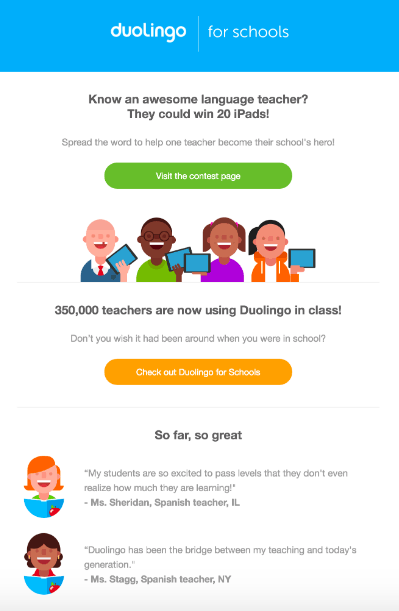
The testimonials add social proof, but so does the statement "350,000 teachers are now using DuoLingo in class!" This presents the solution as reputable and could encourage leads to convert.
Applying this to print on demand, you could reach out to past customers to gather testimonials. Or you could simply list all of the amazing attributes of your products. If you're using Prodigi, you can draw inspiration from the pre-populated 'description' section when looking at one of your products:
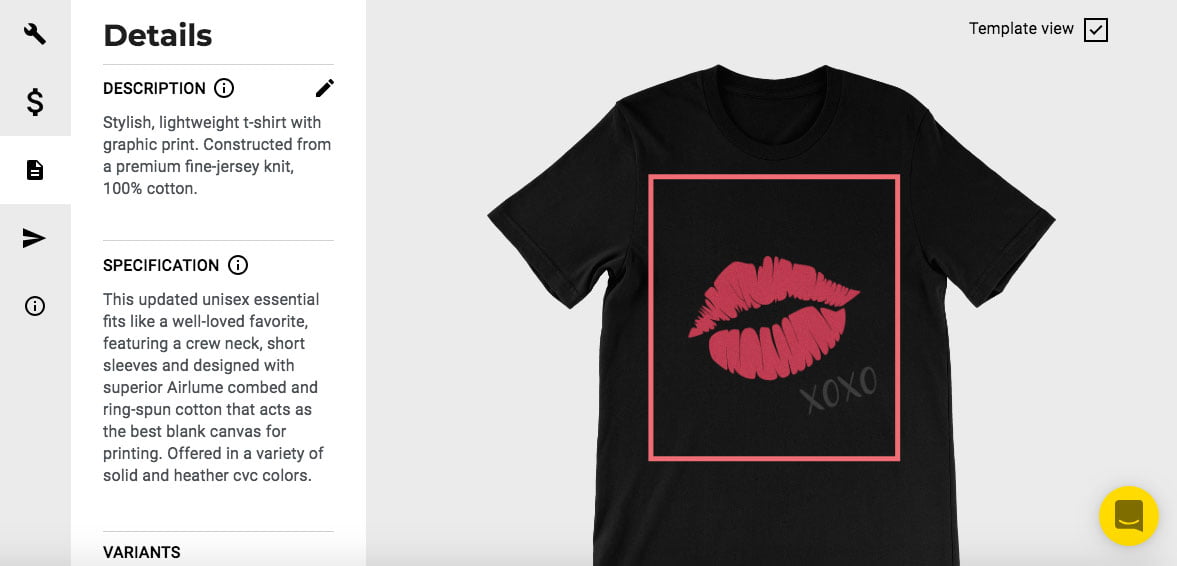
If you would rather go down the informative route, then add value by telling potential customers how they could use your products. This email by designer brand, Kate Spade does just that by explaining how to create a layered look with their bracelets:
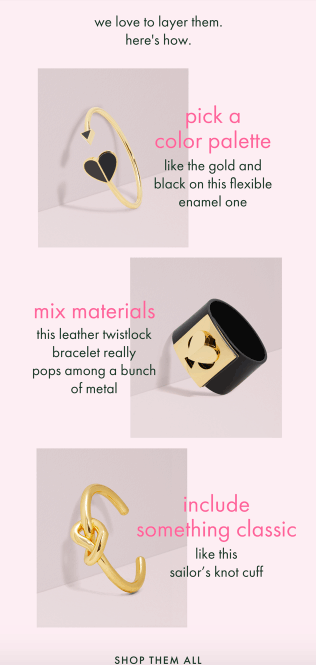
It sounds cheesy, but content like this helps people to imagine what it would be like to own the product(s) and could convince them to make a purchase.
Day Five: Time to sell! (incentive email)
Now it's time to get down to business. By this time, it's been almost a week since you obtained your lead and you want to make sure you can capitalise on their interest before it fizzles out. In other words, you've got to strike while the iron is hot.
It's time to make them an offer they can't refuse. Take a look at this offer from Forever 21:
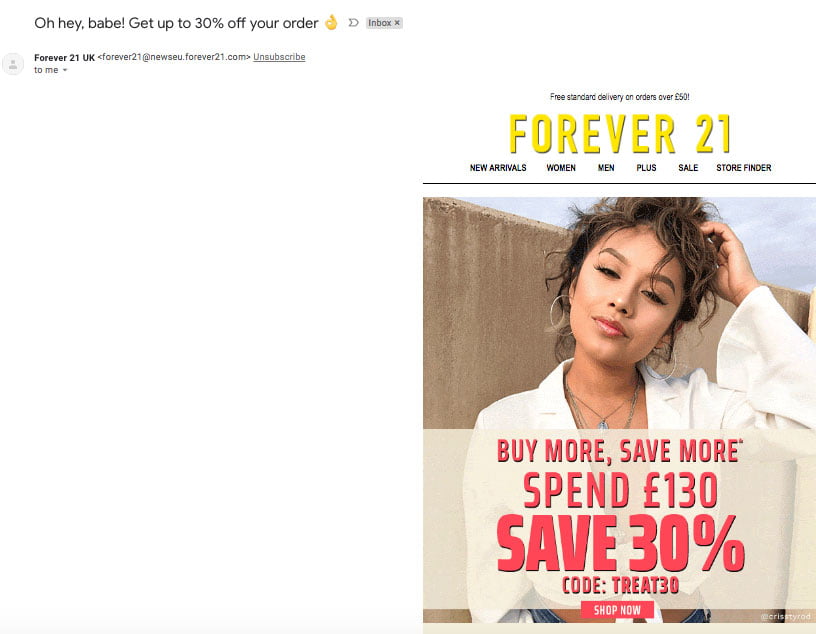
This discount (30%) is quite a generous offer, and could be the extra nudge that the recipient needs to make the leap from lead to customer. But it's not just the offer that gets this email noticed. The subject line is also engaging to the brand's target audience.
"Oh hey, babe! Get up to 30% off your order" will stand out in a crowded inbox. The offer is mentioned, and it is packaged in a way that speaks to young, female millennials (Forever 21's target audience), right down to the inclusion of the 'okay' emoji.
When creating your nurture sequence, it is important to put a lot of thought into your subject lines. After all, this will be the difference between people opening your emails, and ignoring them. According to one study, 47% of email recipients open emails based on the subject line alone; and, using emojis in subject lines is proven to further increase open rates.
Personalisation is also a nice touch. Subject lines that are personalised with a recipient's first name can lift open rates by as much as 20%.
Day Six: A little thank you (educational/value add email)
When your prospect makes the leap from lead to customer, a ‘thank you' is in order. But if you really want to build a long-lasting relationship, you should go even further than that.
Add value by educating customers on how to get the most from their purchase. This email from Framebridge is a great example:
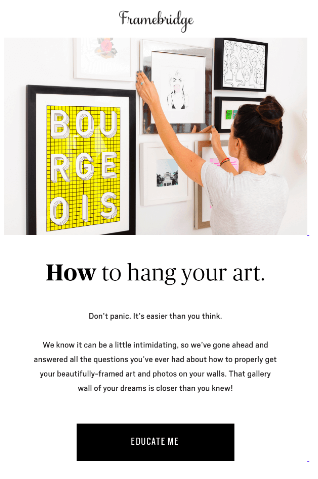
There is also the possibility to upsell here. Do you have any other products that would complement the one the customer just purchased? If so, let them know about it! You're doing them a favour, and, at the same time, increasing profits for your business — it's a win-win.
For example, if a customer purchased a beach towel from you then they might also like a matching tote bag to carry the towel in. Emails like this, because of their helpful nature, are actually welcomed by customers. According to Opt-In Monster, product recommendations can drive between 10 and 30% when you upsell to the right person, at the right time — which is why we recommend sending this email the day after the customer has made a purchase.
Later Date: Re-engagement
Inevitably, all leads go cold in the end. But that's no reason to give up on them! If you haven't heard from the customer in a while then it is time to re-engage them. According to Return Path data, marketers on average send 20% of their emails to inactive subscribers.
If you can identify those people who aren't opening your emails anymore then you can segment them and target them with emails designed to re-engage them. Take a look at this example by ecommerce clothing store, Missguided:

It tells a story, it lets the customer know they are missed, and it ends strong with a special offer. When you consider that 80% of people sign up to email lists to receive discounts, it makes sense to use one as a way to win customers back.
Thanks for reading
An email list is an invaluable tool for marketing and increasing sales — but only if you know how to use it. An automated nurture sequence is the perfect way to slowly nudge your leads towards being customers, while at the same time building a strong relationship with them.
Email marketing is just one tactic for increasing sales but it's worthwhile putting some time into building an automated lead nurturing sequence.
Interested in more useful tips to help you run your print on demand store? Check out our other marketing articles.

